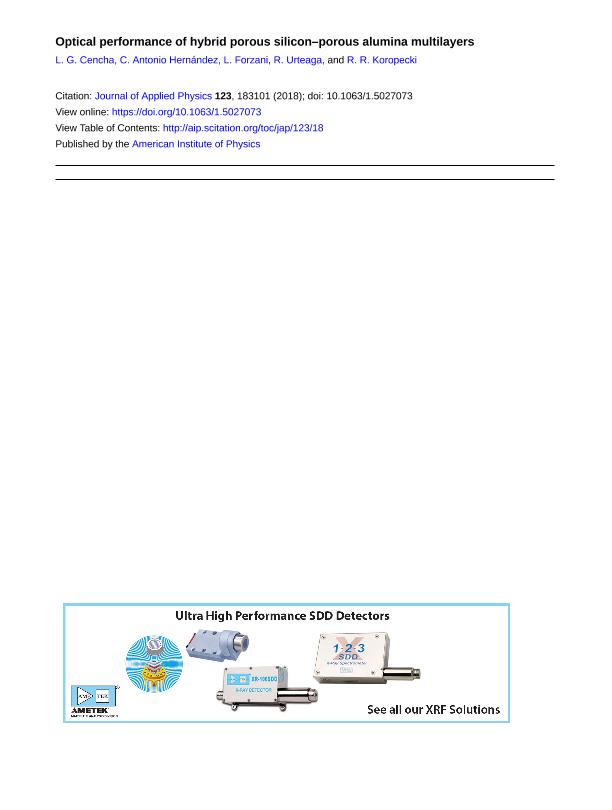Artículo
Optical performance of hybrid porous silicon-porous alumina multilayers
Cencha, Luisa Guadalupe ; Antonio Hernández, C.; Forzani, Luisina
; Antonio Hernández, C.; Forzani, Luisina ; Urteaga, Raul
; Urteaga, Raul ; Koropecki, Roberto Roman
; Koropecki, Roberto Roman
 ; Antonio Hernández, C.; Forzani, Luisina
; Antonio Hernández, C.; Forzani, Luisina ; Urteaga, Raul
; Urteaga, Raul ; Koropecki, Roberto Roman
; Koropecki, Roberto Roman
Fecha de publicación:
05/2018
Editorial:
American Institute of Physics
Revista:
Journal of Applied Physics
ISSN:
0021-8979
Idioma:
Inglés
Tipo de recurso:
Artículo publicado
Clasificación temática:
Resumen
In this work, we study the optical response of structures involving porous silicon and porous alumina in a multi-layered hybrid structure. We performed a rational design of the optimal sequence necessary to produce a high transmission and selective filter, with potential applications in chemical and biosensors. The combination of these porous materials can be used to exploit its distinguishing features, i.e., high transparency of alumina and high refractive index of porous silicon. We assembled hybrid microcavities with a central porous alumina layer between two porous silicon Bragg reflectors. In this way, we constructed a Fabry-Perot resonator with high reflectivity and low absorption that improves the quality of the filter compared to a microcavity built only with porous silicon or porous alumina. We explored a simpler design in which one of the Bragg reflectors is replaced by the aluminium that remains bound to the alumina after its fabrication. We theoretically explored the potential of the proposal and its limitations when considering the roughness of the layers. We found that the quality of a microcavity made entirely with porous silicon shows a limit in the visible range due to light absorption. This limitation is overcome in the hybrid scheme, with the roughness of the layers determining the ultimate quality. Q-factors of 220 are experimentally obtained for microcavities supported on aluminium, while Q-factors around 600 are reached for microcavities with double Bragg reflectors, centred at 560 nm. This represents a four-fold increase with respect to the optimal porous silicon microcavity at this wavelength.
Palabras clave:
photonic crystals
,
microcavities
,
optical sensors
Archivos asociados
Licencia
Identificadores
URL:
http://pubs.rsc.org
Colecciones
Articulos(IFIS - LITORAL)
Articulos de INST.DE FISICA DEL LITORAL
Articulos de INST.DE FISICA DEL LITORAL
Citación
Cencha, Luisa Guadalupe; Antonio Hernández, C.; Forzani, Luisina; Urteaga, Raul; Koropecki, Roberto Roman; Optical performance of hybrid porous silicon-porous alumina multilayers; American Institute of Physics; Journal of Applied Physics; 123; 18; 5-2018; 1-9
Compartir
Altmétricas



